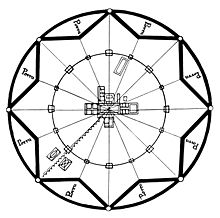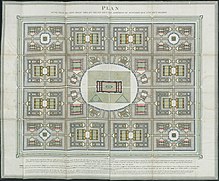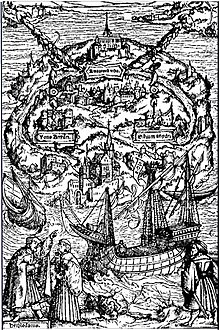Ideal city


An ideal city is an urban planning concept in which a city is designed from the outset under uniform aspects such as economic, social and political organization - often combined with socially utopian ideas and an aesthetic program .
Ideal cities were almost never realized, but had concepts of the ideal city and have influence on the urban planning of the city start-ups , plan cities , satellite towns and housing estates.
features
In contrast to cities that have grown out of a settlement core and thereby also represent existing social structures without special planning, designs for ideal cities often represent desired social structures schematically and use geometrical floor plans such as checkerboard patterns, concentric rings or star shapes.
Historical examples

The oldest known notions of ideal cities, which primarily aimed at political organization, come from Plato and Aristotle , the first plans from Vitruvius . In the Renaissance these ideas were taken up again by Alberti in his De re aedificatoria . Architects and artists from Filarete to Leonardo da Vinci to Dürer also designed ideal cities. Also influential were Utopia by Thomas More and Der Sonnenstaat by Tommaso Campanella . The few ideal cities built include Palmanova and Sabbioneta in Italy . The French chaux of the revolutionary architect Claude-Nicolas Ledoux was merely a literary utopia, based on a realized salt works. According to UNESCO the world's first planned university city is Alcalá de Henares in Spain with its university - it should be the first Civitas Dei ("City of God").
From the Renaissance onwards, there was a strong tendency towards ideal cities , but only a few were actually implemented. One of the most prominent examples of such a facility from this time is the Rhenish Jülich , which was rebuilt according to ideal ideas after a major fire in the 16th century , although the original plan could only be partially implemented. Another example is Freudenstadt , which was built like a mill board game and thus has similarities with Dürer's ideal city. Some mining towns in the Ore Mountains were also built according to this model. Outstanding Marienberg by Ulrich Rülein von Calw (1519).
The principles of the ideal city were also partially implemented in Baroque royal cities such as Mannheim , Glückstadt and Karlsruhe . Generally, the urban dominance of the respective residential palace created by the arrangement of the streets is interpreted as a reflection of the absolutist form of government. In the case of Karlsruhe Palace, for example, the main streets fan-shaped towards the palace tower; The Mannheimer squares and especially the so-called Breite Straße are also oriented towards the residence there.
Inspired by Karlsruhe and Mannheim, Thomas Jefferson had the city of Washington built as the future planned capital in 1792 . Under the direction of the French urban planner Pierre Charles L'Enfant , the city was built in the planned construction period of eight years and was inaugurated in 1800. Even the Mannheim squares can be found there.
In the late 18th century, the architect Claude-Nicolas Ledoux developed the royal saltworks he built in Arc-et-Senans in an ideal project into a large urban utopia with extensive social planning.
Social reform goals came to the fore in the late 19th century with the concept of the Garden City by Ebenezer Howard .
Concepts in the 20th century
New ideal city concepts developed in the 20th century a. a. Walter Burley Griffin with the planned Australian capital Canberra (1913), Antonio Sant'Elia with the Città nuova (1914), Le Corbusier with the Ville Contemporaine (1922) and Lúcio Costa with the planning for the new capital Brasília (1956).
The projects Arcosanti in Arizona (USA) and Auroville in South India are special cases in the sense of an experimental city under the auspices of a city utopia .
See also
literature
- August Buck : The ideal city of the Italian Renaissance . In: Wilhelm Wortmann (Hrsg.): German city foundations of the modern age . Wiesbaden 1989, ISBN 3-447-02970-6 , pp. 17-30.
- Claus Bernet : "Built Apocalypse". The utopia of the Heavenly Jerusalem in the early modern period (= publications of the Institute for European History, Mainz. Vol. 215). von Zabern, Mainz 2007, ISBN 978-3-8053-3706-9 (also: Halle (Saale), University, dissertation, 2005).
- Claus Bernet: The founding of Freudenstadt: New approaches to the most important German ideal city . In: Blätter für deutsche Landesgeschichte , 143, 2007, pp. 107–131.
- August Gebeßler : Freudenstadt - skill and historicity of an ideal city . In: Die Alte Stadt , 23, 1996, pp. 46–55.
- Gerhard Eimer : Urban planning in the Swedish Baltic Sea region 1600–1715. With contributions to the history of the ideal city. Stockholm 1961.
- Ehrenfried Kluckert: On the way to the ideal city. Humanistic urban planning in southwest Germany . Stuttgart 1998, ISBN 3-608-91962-7 (publications of the archive of the city of Stuttgart 78).
- Hanno-Walter Kruft : Cities in Utopia. Ideal city from the 15th to the 18th century between state utopia and reality . Munich 1989. ISBN 3-406-33909-3 .
- Kersten Krüger : The ideal city in the early modern era . In: Frank Braun (Hrsg.): City system and urbanization in the Baltic Sea region in the early modern period . Münster 2004, pp. 11–47.
- Michaela Marek : The ideal city in real socialism . In: Christiane Brenner (ed.): Social history of communism research . Munich 2005, pp. 425-480.
- Helen Rosenau : The Ideal City. Its Architectural Evolutions . London 1974, ISBN 0-289-70201-1 .
- Badisches Landesmuseum Karlsruhe (Ed.): Clear and full of light like a rule: planned cities of the modern age from the 16th to the 18th century . An exhibition of the state of Baden-Württemberg organized by the Badisches Landesmuseum Karlsruhe, Karlsruhe 1990, ISBN 3-7650-9026-3 .
Web links
- Bettina Vaupel: On the charm of planned cities . In: Monuments Online , 1.2015
- Klaus Schäfer: For a different utopia of the city (PDF) in: Institut der Stadtbaukunst, Hochschule Bremen Online 6.2006
Individual evidence
- ^ University and Historic Precinct of Alcalá de Henares . Site of the UNESCO World Heritage Center. Retrieved April 9, 2010.





